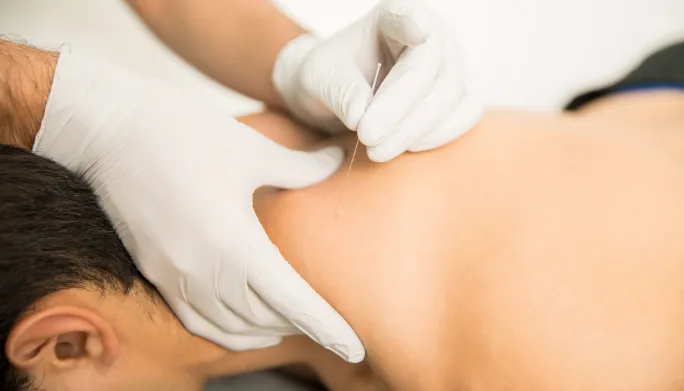Are you tired of traditional treatments that don’t bring relief from lower back pain? This blog post explains dry needling for lower back pain, addressing its concept, effectiveness, and treatment process. Readers will learn about potential risks and gain insights from personal experiences. The content aims to simplify a complex treatment option and provide clear guidance for managing discomfort effectively.
Understanding the Concept of Dry Needling for Lower Back Pain
Dry needling offers a targeted technique for lower back pain by focusing energy on trigger points to influence muscle contraction and reduce strain. The concept contrasts with acupuncture by emphasizing responses around the intervertebral disc. Common indications include localized pain relief, with a mechanism of action that is both practical and well-documented.
Defining Dry Needling and Its Mechanism of Action
Dry needling is a technique that targets trigger points in the fascia and muscles to relieve lower back pain. The method works by inserting fine needles into affected areas, which helps alleviate fatigue by reducing muscle tension and improving range of motion, often resulting in enhanced gait mechanics.
The approach focuses on minimizing deviation in muscle function and improving the supportive role of fascia in stabilizing the back. This treatment method draws on established practices to offer a practical remedy for discomfort and impaired movement, providing tangible improvements for those experiencing lower back issues.
Differentiating Dry Needling From Acupuncture and Other Techniques
Dry needling differs from acupuncture and other techniques in that it focuses on specific musculature points to promote healing and relieve discomfort, a process supported by numerous studies accessible via PubMed. The approach often serves as an alternative to invasive surgery, and practitioners may use a detailed questionnaire during initial evaluations to ensure the treatment suits the patient’s condition, with a clear disclaimer provided regarding potential outcomes.
Practitioners using dry needling concentrate on trigger points found in muscle tissues rather than following traditional energy meridians observed in some other techniques. This method provides a practical route for healing, and clinical reports reiterate the value of this specific approach, emphasizing its effectiveness over other techniques when considering a structured treatment plan.
Identifying Common Indications for Dry Needling in Lower Back Pain
Patients suffering from lower back pain often benefit from dry needling when trigger points are found in key muscle groups, such as the gluteus maximus. Clinical assessments in Poland have shown that this treatment helps improve proprioception and contributes to the overall management of musculoskeletal discomfort.
Practitioners report that targeting specific trigger points enhances the movement system, relieving stress and restoring function for patients with lower back pain. Techniques refined through direct experience continue to support the effective management of pain and improved stability, particularly in cases where impaired proprioception is evident in the affected area.
Evaluating the Effectiveness of Dry Needling for Lower Back Pain Relief
The analysis outlines research studies and clinical trials on dry needling therapy, examines patient outcomes and satisfaction rates, and compares its benefits to alternative treatments such as specific medication and other approaches for muscle discomfort, including the gluteal muscles. Creative commons resources support evidence-backed insights, ensuring readers gain practical information to evaluate dry needling’s role in lower back pain relief.
Analyzing Research Studies and Clinical Trials on Dry Needling
Research studies consistently report favorable statistics for dry needling in mitigating lower back pain, with clinical trials emphasizing its efficacy as an analgesic method when combined with exercise regimes. Open access journals frequently feature these trials, showcasing practical examples of improved movement patterns and reduced muscle stiffness.
Clinical trials also assess the potential risks, such as pneumothorax, ensuring that the approach maintains a strict safety profile during treatment. Evidence from these trials highlights the significant role of dry needling in pain management, offering an effective alternative that complements traditional exercise interventions.
Understanding Patient Outcomes and Satisfaction Rates
Clinical studies report patient outcomes for dry needling show improvements comparable to traditional chinese medicine techniques, with observable changes in skin response and physical function. Research data suggests that addressing the root of muscle tension leads to measurable benefits in lowering discomfort and increasing mobility.
Patient satisfaction rates remain high as the approach targets specific trigger areas to provide physical relief and improved movement patterns. Evaluated data consistently demonstrates that focusing on the root cause of pain produces results in a manner similar to traditional chinese medicine, offering tangible benefits that enhance overall treatment success.
Comparing Dry Needling With Alternative Treatments for Lower Back Pain
Dry needling offers a focused treatment that targets specific trigger points in the affected muscles, differing from alternative methods by emphasizing the role of anatomy and the autonomic nervous system in pain management. Researchers note that addressing stress and muscle tension through precise needle placement provides measurable improvements in both movement and overall comfort.
The procedure stands out from methods like manual therapy and medication by directly engaging the body’s neuromuscular pathways, ensuring treatment effectiveness. Evidence shows that when the autonomic nervous system receives targeted stimulation at key points, patients experience a reduction in stress and improved function, underscoring dry needling’s role in managing lower back pain.
Exploring the Process of Receiving Dry Needling Treatment
This section offers practical insights on preparing for a dry needling session, reviewing medical history and ensuring proper attention before treatment. It outlines a step-by-step procedure for the needles and details physical therapy steps to address inflammation, along with post-treatment recommendations for ongoing relief.
Preparing for a Dry Needling Session: What to Expect
The preparatory stage for a dry needling session involves a thorough review of the patient’s history, which helps practitioners understand any past injury that might influence treatment outcomes. A study of the individual’s muscle activity provides insights to refine the hypothesis on how the treatment could improve flexibility and reduce discomfort.
Before the procedure, clinicians check for signs of bleeding or inflammation to ensure patient safety during the session. This preparation process offers tangible benefits by establishing a clear treatment route and addressing potential issues early on with hands-on expertise.
Step-by-Step Overview of a Typical Dry Needling Procedure
The procedure begins with an evaluation following a strict methodology that mirrors a randomized controlled trial design, ensuring that patient history and physical condition are thoroughly considered before the insertion of fine needles into the skeletal muscle. Experts in medicine implement this process to connect with the central nervous system, thereby addressing localized tension and providing measurable relief for lower back pain.
Each step focuses on precise needle placement aimed at effectively reducing discomfort by influencing muscle actions and nerve signals. The protocol, supported by clinical studies, integrates modern medicine practices to bolster treatment outcomes and enhance the overall movement patterns of patients suffering from lower back pain.
Post-Treatment Care and Recommendations
Post-treatment care after dry needling for back pain involves monitoring patient response by a health professional to ensure that improvements in muscle tension are reflected in better nervous system function and brain responses. A detailed analysis of variance in patient feedback helps practitioners determine the effectiveness of the intervention and tailor ongoing recommendations accordingly.
Patients are advised to follow specific guidelines provided by their health professional to maximize the benefits and support overall recovery. Observations of changes in discomfort levels and muscle behavior offer practical examples for understanding how targeted needling alleviates back pain while influencing the brain and nervous system.
Identifying Potential Risks and Side Effects of Dry Needling
This section covers common adverse reactions like cramp and potential complications, stresses the need for measurement and informed consent, outlines conditions when manual therapy should be avoided, and highlights the influence of advertising in treatment decisions. Experts provide insights on managing risks and ensuring safety through discussions with healthcare professionals.
Discussing Common Adverse Reactions and Complications
Patients undergoing dry needling for lower back pain may experience adverse reactions involving the nerve, with some reporting temporary discomfort during the procedure. Experts in primary care monitor these responses carefully, ensuring potential complications like radiculopathy are identified early to guide treatment adjustments.
Health professionals also consider the unique needs of special populations, such as individuals in pregnancy, assessing changes in perception regarding treatment efficiency. They focus on ensuring that any complications are managed promptly, offering practical strategies that support overall safety and well-being.
Understanding When to Avoid Dry Needling
Patients with certain underlying disease conditions or poor treatment control should avoid dry needling after thorough consultation with a physician. Evidence from research indicates that variations in responses, measured by the standard deviation, may lead to adverse effects in people with complex medical histories.
Experts advise that individuals with chronic conditions or higher risk profiles pause dry needling until their health status is re-evaluated by a physician. Evidence from clinical studies highlights that exercising control over treatment candidate selection is vital to avoiding complications associated with the procedure.
Consulting With Healthcare Professionals About Safety
Healthcare professionals stress the value of consulting with experts to achieve a thorough understanding of dry needling’s stimulation effects and potential risks, such as headache development. This process combines current research with hands-on knowledge and education about safety practices in treating lower back pain.
Medical practitioners encourage individuals to seek expert advice to clarify uncertainties and gain insight into proper techniques. They rely on up-to-date research and experienced opinions to ensure that patients receive accurate education while mitigating possible complications during dry needling therapy.
Recognizing the Role of Dry Needling in Holistic Pain Management
Integrating dry needling with physical therapy offers patients measurable relief by reducing pressure on targeted points, as shown by the visual analogue scale. Combining massage, exercise, and more, this tool aids rehabilitation and supports patient-centric strategies for managing lower back pain.
Integrating Dry Needling With Physical Therapy and Rehabilitation
The integration of dry needling within physical therapy offers a practical solution for patients experiencing lower back pain. Experts note that combining this method with traditional rehabilitation can supplement the role of techniques like acupuncture by providing a direct parameter for managing muscle tension around areas such as the superior gluteal nerve, while reducing reliance on opioid-based treatments.
Clinical evaluations show that patients report improved outcomes when dry needling is applied alongside structured exercise regimens, with results often outperforming placebo effects in trials. Observations from experienced practitioners demonstrate that a targeted approach can yield significant improvements, effectively addressing pain points and supporting overall recovery.
Exploring Complementary Treatments: Massage, Exercise, and More
Complementary treatments like massage and targeted exercise routines significantly support overall pain management strategies. Many clinics use these therapies alongside dry needling to ease muscle tissue tension and promote proper breathing patterns, a method often recommended by primary care providers and featured in reputable articles on lower back pain relief.
Integrating massage, exercise, and additional modalities helps create a well-rounded treatment plan that improves mobility and reduces discomfort. This balanced approach refines tissue flexibility and encourages breathing techniques that enhance recovery, as confirmed by observations from a leading primary care provider in recent clinical studies.
Understanding Patient-Centric Approaches for Lower Back Pain
Recent trials and studies in alternative medicine have highlighted that patient-centric approaches for lower back pain can significantly improve posture and provide effective relief. Observations from clinical experiments reveal that individualized treatment plans addressing conditions such as piriformis muscle tightness yield measurable improvements while aligning with the principles outlined in the declaration of helsinki.
Clinicians incorporate patient feedback and tailored interventions to ensure treatment targets specific pain sources and improves overall function. Their approach, supported by hands-on expertise, demonstrates that a focus on customization and accountability leads to improved results and increased patient satisfaction in managing lower back discomfort.
Conclusion
Dry needling offers a precise solution for addressing lower back pain by targeting specific trigger points within muscle tissues. Clinical evidence supports its effectiveness in reducing discomfort and improving mobility, making it a valuable option in pain management. Practitioners combine this approach with established therapies to achieve tangible improvements and enhanced stability. Patients benefit from personalized treatment plans that deliver measurable outcomes and promote overall well-being.



